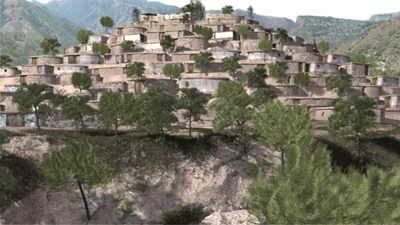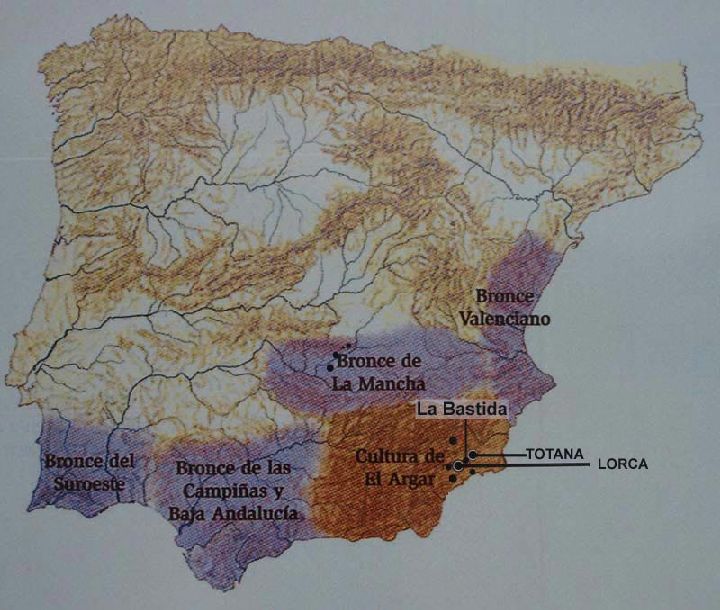 |
| Location of La Bastida in the context of El Argar culture (source) |
Arguable I guess because it will be susceptible to further research for example in the Castro do Zambujal (Torres Vedras, Portugal) or in the El Argar culture area itself but that is what the current archaeological team has claimed through a press release (h/t Pileta).
According to the researchers, La Bastida[es] de Totana (Murcia) was back in the day the largest city in all mainland Europe, next only to some Minoan cities of Crete.
On first read it may sound to exaggeration but, after all, they have pushed forward the age of foundation of La Bastida and hence of El Argar culture to c. 2,200 BCE, some three or four centuries before El Argar proper... what means an older age than the founding of the Mycenaean cities (Mycenae, Athens, Thebes...), which are not older than c. 1600 BCE.
The civilizations of Los Millares and the already mentioned Zambujal (culture of Vila Nova de Sao Pedro), both in Iberia, are still older (c. 2600 BCE) but now La Bastida de Totana stands between these Chalcolithic civilizations and the Bronze Age ones, whose paradigm is El Argar, of which La Bastida may have been seed.
 |
| Hill of La Bastida (Totana, Murcia) - source: La Bastida[es]. |
 |
| Excavated ruins |
Honoring its name (etymologically related to "bastion") La Bastida was a heavily fortified city spanning four hectares on top of an strategical hill. Its 2-3 meter thick stone walls are the oldest known of its kind in all Europe, although they have precedents in West Asia:
The fortification consisted of a wall measuring two to three metres thick, built with large stones and lime mortar and supported by thick pyramid-based towers located at short distances of some four metres. The original height of the defensive wall was approximately 6 or 7 metres. Until now six towers have been discovered along a length of 70 metres, although the full perimeter of the fortification measured up to 300 metres. The entrance to the enclosure was a passageway constructed with strong walls and large doors at the end, held shut with thick wooden beams.
One of the most relevant architectural elements discovered is the ogival arched postern gate, or secondary door, located near the main entrance. The arch is in very good conditions and is the first one to be found in Prehistoric Europe. Precedents can be found in the second city of Troy (Turkey) and in the urban world of the Middle East (Palestine, Israel and Jordan), influenced by the civilisations of Mesopotamia and Egypt. This indicates that people from the East participated in the construction of the fortification. These people would have reached La Bastida after the crisis which devastated their region 4,300 years ago. It was not until some 400 to 800 years later that civilisations like the Hittites and Mycenaeans, or city-states such as Ugarit, incorporated these innovative methods into their military architecture.
 |
| Recreation of La Bastida city (source) |
 |
| Pythos burial, style surely imported from Greece |
Contextualizing
For what I have read on the matter, I understand that El Argar culture, often imagined as a centralized state, would have been divided into three regions or smaller realms, of which the area of Totana and Lorca (roughly modern Murcia region) would be the northern one.
From the pushing backwards of the age of La Bastida I deduce that the this region may well have been the origin of El Argar civilization itself, which surely absorbed Los Millares manu militari later on, maybe leading to the founding of El Argar city as new capital between the two realms, much like Memphis was founded in Egypt after the unification of the Upper and Lower kingdoms.
I am here speculating a bit of course - feel free to correct me if you know better.
Besides of El Argar cultural area, the influence of this state may have extended through much of Southern and Eastern Iberia, possibly into all the areas colored in this map:
 |
| Possible wider area of influence of El Argar civilization, earliest Bronze (source) |
Of course the areas in blank were not empty but had other cultures, in some cases also outstanding civilizations, like VNSP in the following map:
 |
| Middle Bronze in Iberia (anti-copyright by me - same one as Sugaar) |
In the La Bastida dedicated site you can find much more information in Spanish language, as well as photos, about this fascinating site, which was maybe the navel of much of Europe four thousand years ago. Another complementary source for this entry has been the dedicated page of Murcia regional government. Thanks to both.
Excellent post. This brings a lot of precision and context to points I'd only understood previously much more vaguely at much greater levels of generality.
ReplyDeleteThe recreation image, at a gut level, looks a lot like artists impressions that I have seen of some of the larger cities of the mid- to late Bronze Age Hittite empire in Anatolia (ca. 1500 BCE +/- a couple of centuries). This makes sense because it is a connection that your souce notes and fits into the time line several centuries after this fortification.
It is a most interesting matter because if in the Chalcolithic the connections between the Eastern and Western Mediterranean are tenuous, almost anecdotal, in the Bronze Age they become unquestionable, even if not always concise enough for our thirst of knowledge.
DeleteI find most interesting that the oldest true cities in Europe, excluding some Aegean islands, are all in Iberia. This one is not even the oldest one, there are some which are older, from c. 2600 BCE, arguably contemporary with the earliest Minoan palaces (depending on authors) and only a few centuries more recent than Troy I (Troy was in fact much more influential in SE Europe than Crete), contemporary of Troy II.
I can't but think that the ancient Greek legends on Far-Western realms and civilizations, as reflected in the legends of Herakles (Geryon, Atlas and the Hesperides) or in the allegedly Egyptian story of Atlantis, talk of Iberian civilizations and the interactions of the Mycenaean Greeks with them (evidenced specially in some quite clear exchange of funerary rituals between both regions). Later (Iron Age) Phoencian and Phocaean stories on Tharsis/Tartessos seem to refer to another city, probably in Western Andalusia (not located yet, although the Tartessian culture is well defined).
Interesting.
DeleteDo we know if there are any texts from that city/civilisation?
No texts so early, at least not in this area.
DeleteHowever I understand that these and/or neighboring Bronze of Levante cultural area are the ancestors of the proto-historical and historical Iberian culture. The geography of Iberian language (excluding Tartessian) is almost identical to El Argar + Bronze of Levante, with the inclusion of some areas further North (Catalonia, parts of Languedoc), which clearly swapped cultural zones in the 6th century BCE, after the founding of Massilia and Emporion.
So, while not demonstrated, it seems quite reasonable to think of them as proto-Iberians. Since the Late Bronze Age, El Argar presumed polity appears to split in many city-states known collectively as post-Argaric culture. There may have been a larger polity further SW (Tartessos) but in Eastern Iberia political unity would not be achieved again, it seems, until the Barcids, a colonialist force.
It must be noted in this regard that there were two slightly different Iberian scripts (not before the 7th century BCE), one in the Levante area and further North and the other mostly in the former Argar area. This may reflect the dual origins of Iberian ethnic identity and language.
http://www.facebook.com/LaBastida.Totana
ReplyDeletehttp://www.la-bastida.com/inicio/index.html
Sorry, some things are being translated for the english version of the official website.
I already had posted the second link in-text several times but I appreciate your interest anyhow, Carlos.
DeleteDo you think the entry is correct or would you suggest any improvements?
(Si te sientes incómodo en inglés, puedes responder en castellano, claro - aunque el inglés es preferible porque así lo entiende más gente, al menos en este blog).